The last time we visited this old piece of ecclesiastical goldwork embroidery that we’re deconstructing, we looked at the lily on the piece and discussed the order of work.
There are several elements on the piece that deserve individual attention: the grapes (which we’ve already taken apart), the lily, the rose, the wheat ears, the leaves (all taken together), and finally, the central element, the Lamb.
Today, we’re going to look at the rose. It’s much the same as the lily, so we’ll talk a little bit about the order of work on it, the thread direction, the forms and padding, and then an interesting little clue that tells us a little more about the whole embroidered piece.
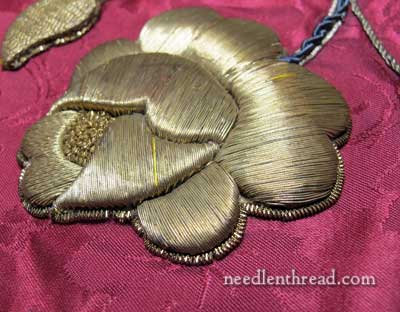
This is the goldwork rose. It’s another high relief piece, made in the same manner as the goldwork lily. The metal threads on it consist of a smooth passing thread, a roccoco thread (the wavy thread at the very tip of the rose), and some chip work (the inside sparkly bits made from check purl, which we’ll talk a little bit about).
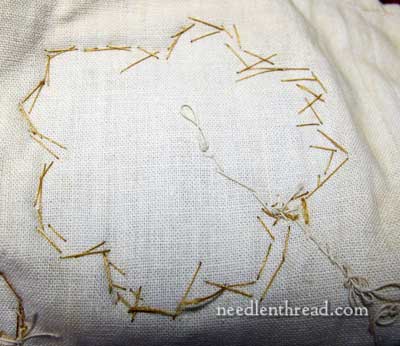
Here’s the back of the vestment piece, where you can see the threads used to appliqué the rose to the fabric. There are actually two rounds of thread here – the inside round of shorter stitches are used to hold the rose in place, and the outside round of longer stitches are the stitches used to couch the check purl all around the outside of the rose.
So, first thing, I clipped these threads on the back, to lift up the rose.
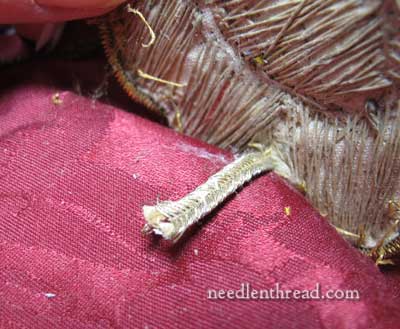
When lifting up the rose, behind it I found the tail of the “stem” that scrolls through this whole design. See it?
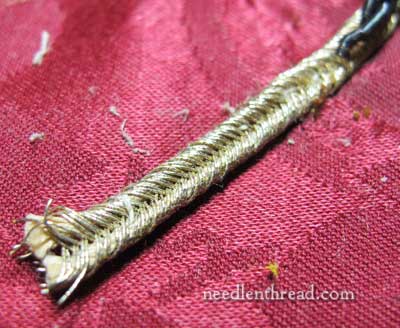
This is the base of the stem. It’s a thread that I know as Russian braid. It’s made from two parallel cords that are plaited together with the metal thread, so that there’s a “groove” running down the middle of the whole cord. It’s couched on here down the middle of the cord. Running down the center groove in the cord are purls:
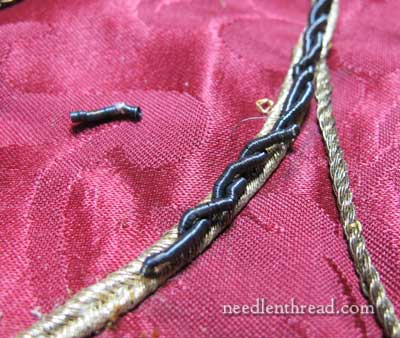
The purls are sewn in an “s-ing” method, and they have oxidized to almost completely black. On the backside of the purls (and you can see it a little bit on that stray purl in the photo), you can still find a hint of gold, but it’s barely a hint. I think this extreme oxidation points to a higher level of silver in these particular metal threads, as compared to the other threads on the piece.
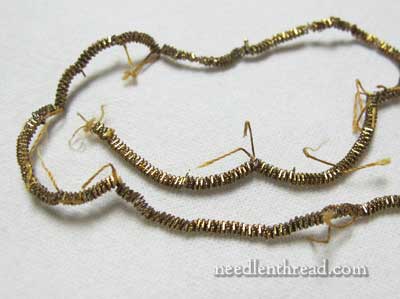
Here’s the check purl outline from around the rose. If you look closely at this stuff (we’ll look a little closer at it below, when we talk about the chip work), it’s not quite the same stuff as the “bright check purls” in the English metal threads we use today. This stuff reminds me of the check purls available as Sadi threads.
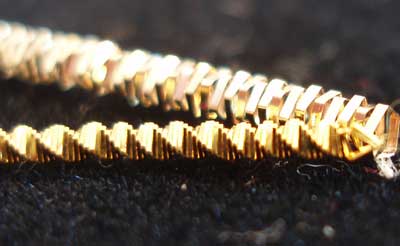
Here’s a photo comparison of English bright check purls (front) and Sadi threads. The stuff on the piece we’re deconstructing is not exactly like the Sadi thread, but it doesn’t twist the same way the English bright check purls twist.
So it’s not quite the same thread that we would use today, at least in the shape of the crimp and twist in the thread, as far as I can tell. I plan to look at it closely under a magnifier and really compare the three threads, to note the differences, but I haven’t done that yet.
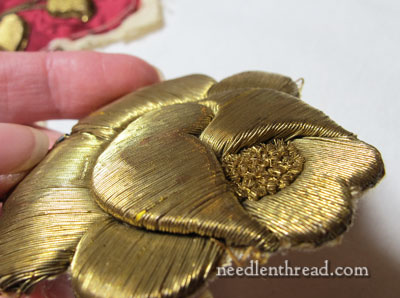
Back to the rose itself. We can get a better idea of the order of work on the piece, if we look at it sideways because we can see the dimension better.
The top back petal at the tip of the rose (worked in the wavy rococco) is flat and is overlapped by the two fat center petals of the rose. The fat center petals also sit on top of the outside lower petals of the rose.
So we know that the back petal at the tip of the rose and the lower outside petals would have been worked before the two large main body petals of the rose would have been worked. The last thing to happen would be filling in with the chip work in the center of the top of the rose.
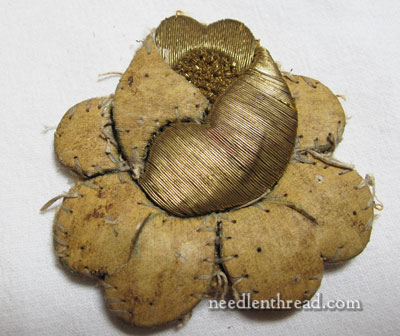
The two little side petals on the outside of the rose were worked separately. The two large petals on the outside base of the rose were one continuous pair of gold threads. The two inside overlapping petals were worked separately.
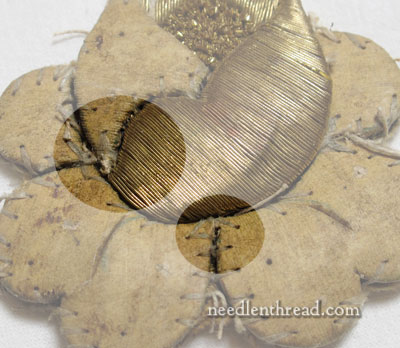
As far as the forms go, the two large overlapping inside petals that make up the “body” of the rose were actually one form at some point in time. The form is broken – whether this happened during the embroidery or later on, I’m not entirely sure. I think it may have happened during the embroidery, since the embroidery on each of those petals was worked separately. There’s no thread that carries over the base of both petals.
The form on the two lower outside petals were also one form at some point. These petals, however, were worked with a continuous pair of threads with no break in them, so I suspect the petal forms here cracked after the embroidery was done.
Strangely enough, I’m going to take a guess that the forms were made for the threads (at least on those outside lower petals) to run perpendicular to the split in the middle of the petals – but in the actual embroidery here, the goldwork threads run parallel to the split.
If the embroiderer wanted that split (or vein in the petal) to show on the top of the embroidery, the goldwork threads would have had to run perpendicular to the split. I think the rose would have certainly looked better with the splits worked on the top and visible, to give the flower at least some “life” – if you look at the original picture of it above, though it is pretty and obviously a rose, it’s rather blobby and unbroken along those two large petals.
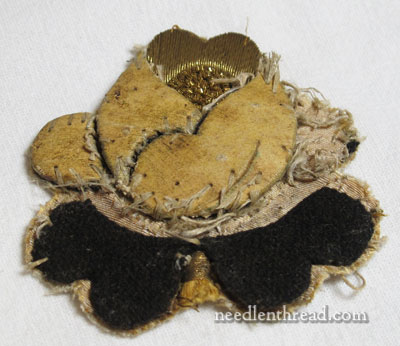
Another interesting thing – the padding on this particular element is attached to the forms (as it was on the lily) except for these two lower petals, where the padding was actually sewn down separately from the forms. Not sure why.
On this piece, the two center overlapping petals had the most padding, with very thick felt underneath them. The outside petals had this thin layer of felt that’s sewn down separately, plus a thin layer of felt attached to the form. There’s no padding under the inside petal at the very tip of the rose, except for the form.
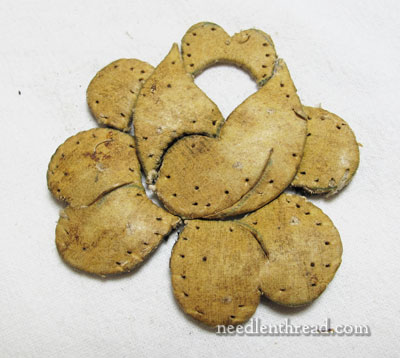
And here’s the form, all cleaned up.
Incidentally, many readers have asked if the forms could have been pre-made and purchased. This occurred to me, too, but I have scoured every old ecclesiastical embroidery book I have, and found no reference to purchased forms. There’s reference to cutting forms (card foundation), and to using forms, but no reference to “purchasing” forms. So I don’t know. If anyone else has ever come across any references to pre-made, purchasable foundations for goldwork like this, I’d love to hear about it!
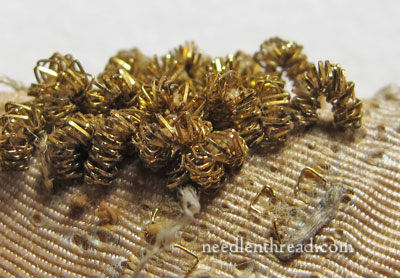
Here’s the chip work up close. Notice that it’s not cut and sewn down flat. It’s actually looped up and sewn on in the shape of an arch. Kind of like a itsy-bitsy Slinky toys!
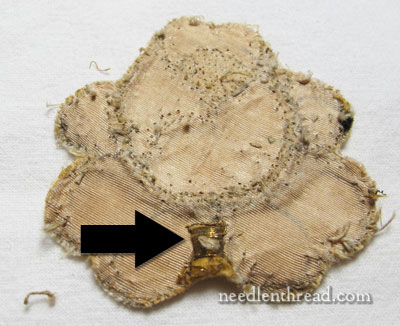
Finally, the fun part.
See this blob on the foundation fabric? This is gold passing thread (not the same thread that covers the rose) wrapped around a thick, dark yellow string foundation. It is trimmed very carefully to fit the shape of the rose. It was not connected to any threads on the rose itself.
This looks like where a stem would be attached, right?
But the stem – well, we looked at it above. It’s Russian braid. It doesn’t have a deep yellow string foundation, hand stitched over with gold passing thread.
Let’s go look at the lily.
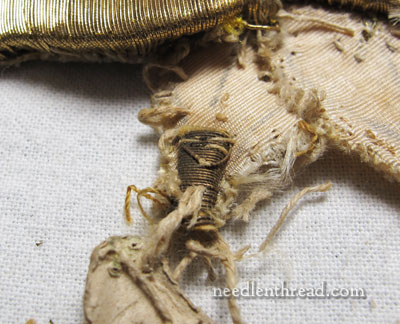
Oh my goodness! Look! The lily has the same thing. Completely unconnected to the other threads on the lily (in fact, it was under the base of the lily, which was stitched with rococco), padded with a deep yellow string, covered with a different gold wire thread, and trimmed very carefully to the shape of the lily so that it fits underneath and is not noticeable.
So, what does that tell us?
I think it’s a fairly good clue that these elements all came from a different vestment and were salvaged and put onto a new ground. These thick chunks are most likely the tips of the original stems.
So that’s the rose. Next up, we’ll check out some leaves, which are all pretty much done the same way, and then the wheat ears, which are interesting little things and can tell us much, and then finally, the Lamb in the center, which is rather complex.
Any questions or comments? Feel free to leave them below!
If you’d like to read the backstory on this project of Deconstructing Goldwork, check out the Deconstructing Goldwork Index, where you’ll find all the articles related to this listed chronologically.







Could you please give the references for making and using the forms that you mentioned in today’s (3/8/13) blog?
Oh, my – I would have to dig through a collection of books, Rozelle. If I have a chance, I will. Basically, what I’ve seen in older books are instructions along the lines of “cut card for foundation” – no real specifics. But I’ve never seen “use a purchased card foundation…” I’ve never found any mention of purchased, pre-made foundations. Anyway, if I have a chance, I’ll look up specific books where raised embroidery is discussed. ~MC
Thank you Mary! De-constructing this piece is very exciting, I cannot wait to see the lamb’s piece. Thank you very much, you do an excellent job.
Susan
Fascinating! My guess on the padding for the 2 lower petals is that after the goldwork was done, someone decided it would look better with padding. And about the stitching direction – even if the embroiderer didn’t want to couch the veins, it would have been better to split that bottom form and had both petals parallel to the vein indentation. Rather than both petals worked in the same direction. At least IMHO.
I’ve never seen forms like this, but I have seen card forms in antique shops and in books for alphabet letters and for some art deco style shapes–mostly open oval shapes with pointed ends. These were made for embroidering over with cotton threads. I wouldn’t be surprised if such forms were made, but even back then goldwork was not a common household art so the forms may have been of limited availability and not advertised to the general public. (Or, like certain threads, available only in certain areas of the world.)
Very good point! You don’t often find highly specialized stuff in the old adverts…
Amazing, the amount of work that went into the piece also the amount of work that you have done to demolish it! Have followed it all and thoroughly enjoyed it. Sad it had to be broken up but what a lesson it has taught us all. Thank you very much for your time and trouble. Can imagine it must have been a dirty job behind the scenes.
Very dirty! It’s like counting money, in a way – your hands get dirty, and then there are all the bits and dust from the piece….
Dear Mary
Thanks for another interesting deconstruction of the goldwork embroidery. The Russian braid cord is interesting the way it is made I wonder if that sort of braiding is used today. The bare components are strange looking I wonder how they obtained them and how they were made and was this generally used for the padding?
It’s interesting that the goldwork is similar to the gold that is used in needlework today even the way it is embroidered onto the piece as in the chip work etc. Thanks for your time and patience in giving us such detailed description of the deconstruction of antique embroidery fascinating.
Regards Anita Simmance
Aloha Mary,
Could we call this Kaansas Mary and the Vestment of Discovery ? lol It is fascinating.
ji
This tale continues to reveal new twists – no pun intended. My guess is that the original items (those the various pieces came from) were made in a dedicated ecclesiastical embroidery workshop, where repeated use of motifs would make die-cut cardboard forms and shaped metal pressings economical to buy in. That would also explain the slits in the petals – other variations of the same basic design might need them, while these heavy pieces don’t.
I wonder if a slight untwisting of the English check purl would give the same effect that you see on the rose edging? I am not a gold worker, so that’s just a guess from looking at it.
I’m waiting eagerly for the next installment of your fascinating detective novel….
Yes, you’re right – the check purl used as the filling is the same check purl used around the outside of the rose. Interesting thought about the original workshop, too! I would guess the same thing – that they had a supply of forms and so forth on hand. -MC
wow Mary. Thanks for explaining to us the techniques in detail. It leaves me speechless everytime I read the post on deconstructing the needlework. superb articles & I eagerly await the mail everyday. & the embroidered eggs are awesome…Harinakshi, Mumbai, India
Hi Mary,
I have been reading your website blog posts off and on and will be practicing your stitching techniques from the videos-
I dont recall whether i emailed you earlier but i just wanted some advice from you actually since i dont have experience with it myself: I want to embellish some sweatshirts and tshirts for myself and instead of embellishing directly i will be sewing in beads, sequins etc onto fabric and then stitching the patches onto the sweatshirt or tshirts- What base fabric should i use for the patches? Im thinking either organza or tulle but love to hear your thoughts- i dont like the effect from felt- Thanks so much 🙂
Regards
Abbas
Hi, Abbas – I think you can use any fabric that works, for patches like that. If you’re doing heavy embroidery, I don’t know that organza would be the fabric of choice, but you can always try it! Do a sample and see if it works the way you want it to.